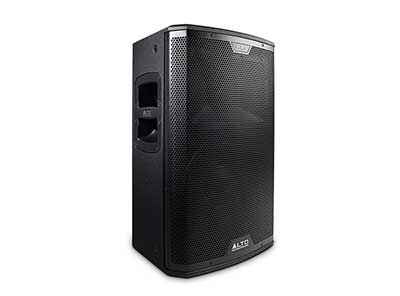
Over the past 18 months, I’ve reviewed the following portable P.A. products in a variety of applications and environments, such as small- to medium-size clubs/music venues, outdoor/amphitheater environments, street festivals, old creaky wooden theaters, low-key coffee shops and restaurants, houses-of-worship, schools/municipal environments, and literally on the side of the road.
Here are those I’d recommend, categorized per manufacturer and in alphabetical order.
Alto Professional’s Black Series range includes the Black 12 two-way full-range pair ($599 street, each) with 12-inch LF transducer and 1.75-inch HF driver, and accompanying Black 15 SUB subwoofer with 15-inch long-excursion LF driver ($1,099 street). Built of 18mm plywood and adorned with various beefy custom-molded handles, stand and pole mounts and rigging points with a steel speaker grille, this is not a lightweight P.A. It sounds great and offers a noted 1,200 watts of continuous power.
All Black Series components are ready to work with Alto Pro’s Live Drive wireless speaker app for iOS, allowing for level matching, EQ adjustment, compression, time-alignment, and more. Also included per component is an extended-range (up to 100 feet) Bluetooth antenna for wireless device pairing.
In review, I immediately noticed the smooth HF response of the Black 12 tops; it reminded me more of a refined studio monitor than a portable P.A. speaker. Musicians commented that it sounded “classic,” “full,” and “not hyped.” Most importantly, the Black Series stands up performance-wise next to competition costing literally hundreds of dollars more per component.

Bose’s F1 Flexible Array Loudspeaker System is a simple, yet very real line array for Portable P.A. (PPA) applications: a front-of-house sound reinforcement rig covering a range of audience sizes and types with proprietary Bose FLEX array technology, and as easy to position and carry as any typical “black box” gear. For two months, I used an F1 rig (two full-range cabinets and two accompanying subwoofers) in various live sound applications and am sold on its quality and impressive sound via its unique design, build quality and components.
At first glance, the self-powered 1000W Bose F1 Model 812 Flexible Array Loudspeaker looks much like other similarly sized PPA gear. It measures 26.1×13.1×14.6 inches (HxWxD) and weighs 44.5 pounds; its accompanying self-powered sub, the 1000W F1 Subwoofer, measures 27×16.1×17.6 inches (HxWxD) and weighs 57 pounds. Both are easy to carry and are notably scratch and impact-resistant thanks to a proprietary blend of polypropylene ingredients. Together, Model 812 and F1 Subwoofer system conjoin with the sub’s unique built-in speaker stand, creating a sturdier-than-pole-cup, very attractive full-range/subwoofer tower. A standard pole cup is also included on the bottom of the Model 812.
The Model 812’s main appeal, however, lies in its simple-to-use Flexible Array technology, a first for the PPA market. Users can shape coverage patterns by manually moving its top and bottom array; in total, the Model 812 features a vertical line of eight small midrange/high frequency drivers plus a 12-inch woofer. Both the Model 812 and F1 Subwoofer have street prices of just under $1,200 each.

Cerwin-Vega’s P-Series is one of the company’s two powered live loudspeaker lines, the other being C-V’s flagship CVA Series—quite possibly the best all-around Portable P.A. gear I’ve ever used. The CVA is overbuilt in a “tour-grade” way and sounds incredible. The P-Series incorporates some notable CVA-influenced features, as well as a variety of unique and useful touches. For the P-Series review, I received a P1000X pair (at $699 street, each), a two-way bi-amped full-range bass-reflex speaker featuring a 10-inch LF driver and a 1.75-inch HF driver; polypropylene cabinet with steel accents and handles incorporating a flush waveguide and 18 gauge perforated steel grille; and a Class-D amp providing 1000W of peak power.
After several months of use in a half-dozen gig applications—club/theater, outdoor venue and rehearsal use—I found the P1000X to be a great stage monitor and main speaker when used as a pair coupled with a powered subwoofer. It’s plenty powerful in most PPA applications and seems to be physically overbuilt in typical Cerwin-Vega fashion, with an overall better and thicker grade of polypropylene than I typically find in this category.

Electro-Voice, in my experience, is a no-brainer source of PPA options. One of my favorite “workhorse” lines of the last few years would have to be the ZLX Series by Electro-Voice. At $349 street, the ZLX-12P powered two-way speaker is a true bargain that works incredibly well as a main, monitor or auxiliary speaker; especially handy is its 2-channel built-in mixer and 1/8-inch input for playback, making it ideal for singer/songwriter jobs and beyond.
The EKX Series, E-V’s mid-level PPA, offers powerful-yet-efficient performance, unique and valuable DSP features, as well as road-worthy construction at an amazingly good value. To review, I received a pair of EKX-15P 15-inch two-way powered loudspeakers ($799 each, street) and a pair of EKX-18SP 18-inch powered subwoofers ($899 each, street), comprising a flexible PPA rig capable of handling a lot. Like all EKX Series components, this E-V review rig features QuickSmartDSP functionality, accessible via a one-knob interface and accompanying LCD screen for easy setup. Input-wise, the EKX Series is rather comprehensive.
The EKX-15P features a 1,500W Class-D power amp providing 134dB maximum SPL. Meanwhile, the well-matched EKX-18SP features a 1,300W Class-D power amp providing 134 dB maximum SPL. EKX’s sub notably provides Cardioid Control Technology, which steers its delivery to the audience with a 35dB reduction on stage with multiple subs (as in at least a pair) deployed. Together, this rig creates what can best be described as a sculpted, waste-free sonic impact in use. The EKX Series is a modern tool in that it is efficient and seems to require less corrective EQ before input.

Visually, Mackie’s black polymer-encased 9.5×17.8×9.1-inch FreePlay Personal P.A. chassis best resembles a new century “boom box.” As a child of the ’80s, I was thrilled to use it as such, too: outdoors on the beach, while camping, and at any potential performance location for both playback and performance. The quick scoop? FreePlay is my favorite boom box, ever.
Most importantly, Mackie’s FreePlay is a perfectly capable small P.A., one that is ideal for coffee shop-style singer/songwriter uses, quick and easy sound reinforcement tasks, and so on. It boasts 150W (RMS) and 300W (Peak) of power. Its frequency response is an impressive and full-sounding 65 to 20k Hz. It’s a stereo playback system: left and right high-frequency drivers with a shared, green-tinted 8-inch LF woofer. A built-in 4-channel digital mixer plus effects (featuring well-chosen minimalistic reverb settings, two delays, four stereo mix EQ settings and a Feedback Destroyer for open mics and DI’d inputs), two mic/line preamps, an 1/8-inch input and ¼-inch monitor output comprise the FreePlay’s simple I/O scheme.
Additionally, consider Bluetooth playback and the FreePlay becomes a real problem-solver. For example, it’s a perfect solution for a restaurant patio’s program music playback and its visiting singer/songwriter on Fridays; and, with battery-powered capabilities (standard D batteries or via optional rechargeable Lithium-ion), it can move anywhere necessary.
Having recently evaluated FreePlay, the subsequent arrival of a Reach PPA system for review made a lot of chronological sense. While FreePlay is the easiest PPA I’ve ever traveled with, one Reach enclosure will deliver both main and dual stage monitor duties quite well in many small- to medium-sized rooms.
Bluetooth features take Reach to an entirely different level than its closest competition. With the free Mackie Connect mixing app—allowing level, EQ, effects, monitoring and other adjustments—Reach is truly a tether-free system with the simplest, most logical of touchscreen mixers I’ve had the benefit of using live. Usefully, it pairs with OSX and iOS as well as Android devices.

Elite Acoustics Designs’ Sunburst Gear M3BR8 could be the most useful multipurpose monitoring tool I’ve ever used. Is it a studio monitor, instrument monitor, sound reinforcement speaker, Bluetooth-ready portable DJ/KJ rig, remote-location battery powered portable P.A., or a 3-channel mixer with limited EQ? Actually, it’s all of those and more.
Designed, built and tested in the U.S., the M3BR8 is notably well built and ideal for mobile artists/recordists, such as those who frequently find themselves performing and producing on the go. The magnetically shielded, front-ported M3BR8 features a 5.25-inch woofer and 1-inch tweeter; three input channels featuring XLR and TRS inputs plus 1/8-inch auxiliary jack with volume knob; 3-band master EQ; long-lasting 15-plus hour rechargeable battery; AC/DC operation; Bluetooth playback-ready; separate USB input and charge ports; and 35 mm bottom pole mount with a very sturdy overall build quality and road-ready design. Dimensions are 9x9x14.5 inches (LxWxH); per cabinet weight is 23 pounds.
The M3BR8 surprised me with its studio monitor–level performance, as it’s built to handle small sound reinforcement tasks, too. Trust me, this is no typical portable P.A.; I’d feel comfortable mixing on MM Series speakers as well as listening for enjoyment because they sound great and are relatively accurate. Solid as a brick, everything about the speaker feels very high quality—from its knurled aluminum pots, carbon fiber-look covering over thick wood cabinetry to its minimalistic, sleek steel handle. The look is a toss-up between modern-day design and lab coat-era recording products. Based on overall quality and flexibility alone, I predict a growing buzz around the Sunburst Gear brand in 2016 based on the MM Series in particular.

Yamaha’s DBR Series—offering DSP, amp and speaker technologies pioneered in Yamaha’s higher-end DSR and DXR Series PPA systems—comes in lightweight, affordable packages for lower-impact applications. For this review, I received a pair of DBR10 full-range powered loudspeakers (at $399 street, each). Features include a 10-inch LF cone driver and 1-inch throat compression driver with ferrite magnets with 700W peak power/325W continuous (LF: 260 W, HF: 65 W). Dimensions are 12×19.4×11.4 inches and weight is a mere 23.2 pounds.
Processing-wise, the D-Contour switch offers frequency curves for FOH/Main, Monitor or off/bypass settings, plus two HPFs at 120 Hz and 100 Hz, respectively. The DBR Series isn’t necessarily built to compete with the current “1k W club” of PPA powered enclosures, yet it’s powerful enough to offer what users need in many small-scale sound reinforcement applications.
This DBR10 pair shines as rehearsal wedges/monitors, auxiliary instrument speakers, sole singer/songwriter amplification, and more. For under $400 each, I’d readily recommend the DBR10 as a solid PPA component to cover coffee shop-type gigs or musician-toting personal stage monitors—they’re ideal for applications in which lighter weight is a necessity, yet both power and clarity are desired.
Strother Bullins is Technology Editor for NewBay Media’s AV/Pro Audio Group, active musician, recordist and small-venue sound reinforcement wrangler.


